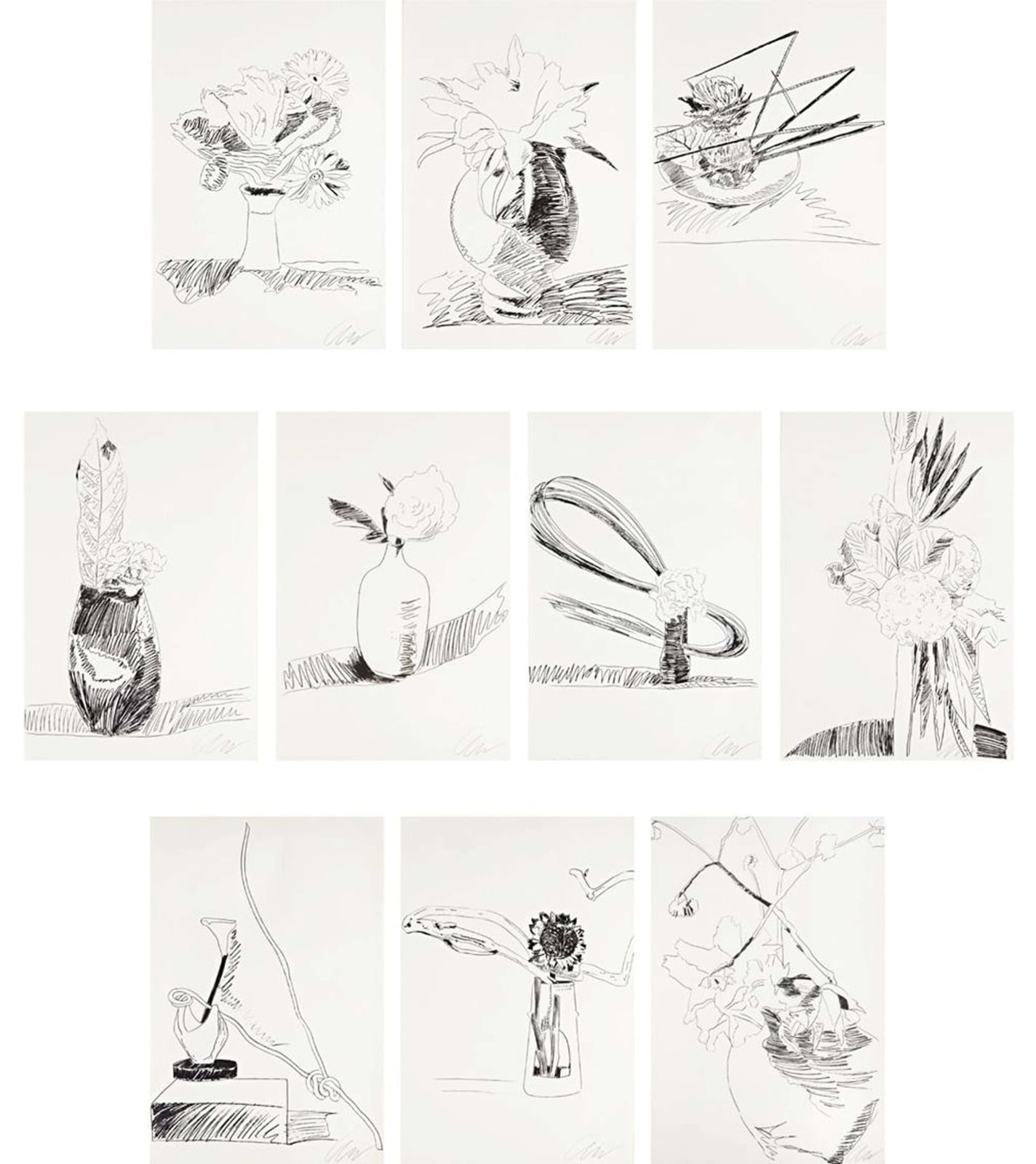
Andy Warhol
Each signed and numbered in pencil on verso, initialled in pencil lower right.
101.6 x 68.6 cm
Flowers i(Black and White) (FS. II 100 - 109) s a portfolio of ten screenprints created by Andy Warhol in 1974. While produced through his signature screenprinting process, these works are based on Warhol’s own original drawings—merging two of his most essential mediums: illustration and print. That same year, Warhol also released a hand-colored version of the portfolio, titled Flowers (Hand-Colored), offering a more playful and painterly counterpoint. Each print in the series features a different flower in a unique arrangement, often adorned with whimsical details such as feathers or ornate vases.
This portfolio holds particular significance within Warhol’s body of work, as it reconnects with his artistic origins in drawing and commercial illustration. Long before his fame as a Pop artist, Warhol was celebrated for his expressive, delicate draftsmanship—a skill that is vividly evident here. By transferring these drawings to silkscreen, Warhol creates a compelling dialogue between the private, spontaneous act of drawing and the repetitive, industrial aesthetic of printmaking.
The Flowers portfolio marks a tonal shift from Warhol’s more familiar subject matter—celebrity portraits, consumer products, and mass media iconography. These floral prints exude a tenderness and charm that feel distinct from the polished detachment of his Pop persona. The domestic intimacy of the imagery, with its whimsical flourishes and decorative objects, brings to mind the quiet spaces of home and everyday life rather than the glossy world of fame.
While at first glance these works may seem like an outlier, they reflect Warhol’s consistent drive to evolve and defy expectations. Throughout his career, he frequently returned to nature as a motif for more personal, emotionally resonant projects. Earlier examples include the Flowers series of 1970 and his Sunsets portfolio—both marked by a contemplative, atmospheric quality far removed from his commercialized imagery.
Warhol treated the subject of flowers with remarkable versatility over the decades. His first “Pop” take on the theme came in 1964, based on a magazine photograph of hibiscus blooms. This image was later expanded into the iconic Flowers series of the late 1960s and early 1970s, marked by bold color and repetition. However, the 1974 Flowers portfolio revisits the subject with a different sensibility—trading photographic source material for original drawing, and saturated color for monochrome simplicity or hand-colored spontaneity.
These works are not just decorative—they are deeply tied to Warhol’s identity as an artist. The choice to return to drawing, to embrace imperfection and expressive line, reveals a quieter but no less intentional aspect of his creative voice. It is a reminder that beneath the mechanical façade of Pop Art, Warhol remained deeply connected to the fundamentals of image-making: composition, gesture, and emotional nuance.
Warhol’s Black and White Flowers (1974) complete portfolio is a graceful testament to his artistic range. By blending his foundational skill in drawing with the silkscreen technique that defined his Pop era, Warhol bridges two creative worlds—one personal and intuitive, the other industrial and reproducible. These prints offer a moment of reflection within his broader career, revealing a softer, more introspective vision of beauty and form.
They remind us that Warhol’s legacy is not only built on cultural commentary and celebrity iconography, but also on his enduring ability to reimagine and reinterpret the familiar—whether in a soup can, a silver screen star, or a single, delicate flower.
For more information on Andy Warhol's Flowers i(Black and White) (FS. II 100 - 109 )complete portfolio for sale or to buy Flowers (Black and White) (FS. II 100 - 109) contact our galleries using the form below.